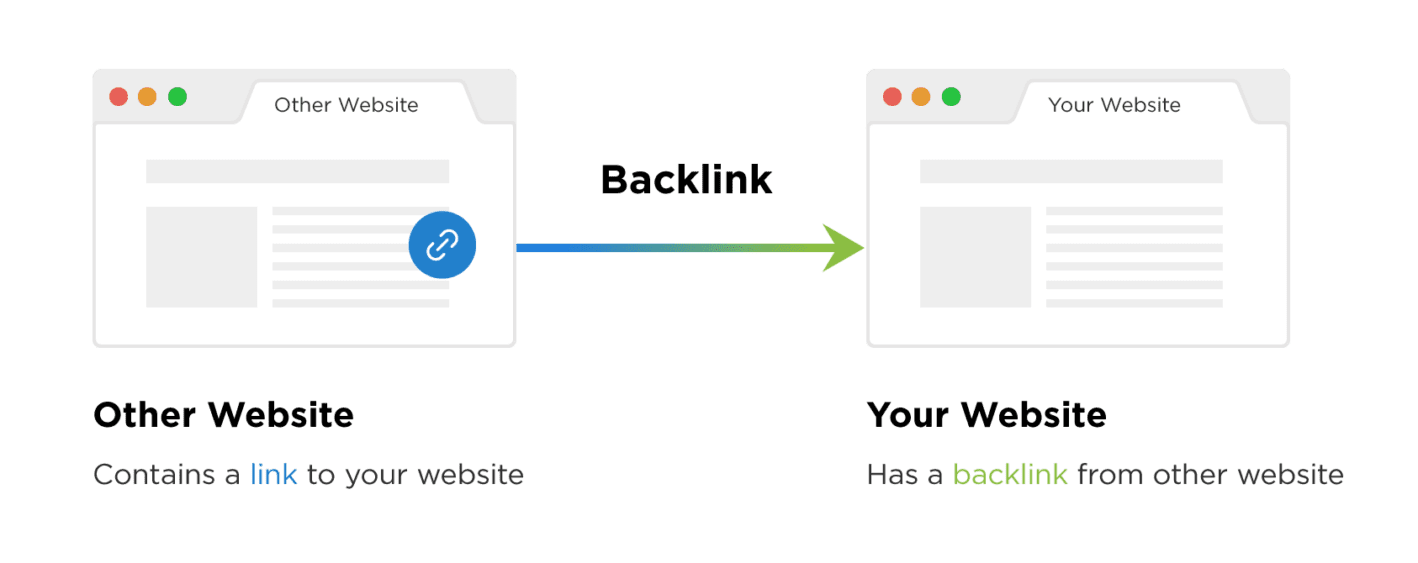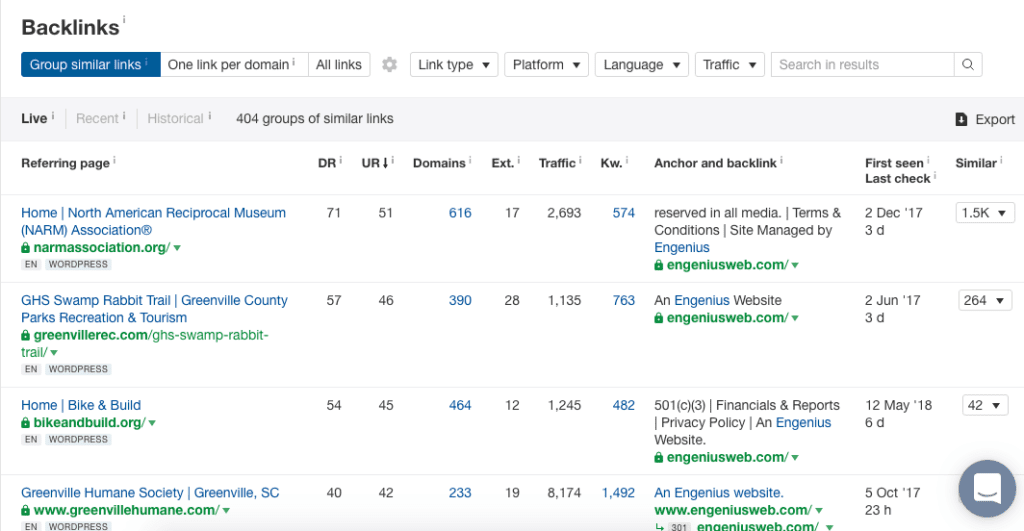Backlinks are foundational to SEO. Most SEO’s agree links carry the most weight in Google’s algorithm. If you don’t have a good understanding of backlinks, don’t expect to get much traffic from search engines. In this post, we’ll take a look at:
- The Anatomy of a Backlink
- How to Track and Measure Backlinks
- The 5 Most Effective Link Building Strategies
What Are Backlinks?
A backlink is a hyperlink on a website that links to another website. It’s called a backlink because it’s a link that points back to a website. Backlinks are also known as inbound links or incoming links. The opposite of a backlink would be an outbound link, which is a link that points from your website to another one. When considering SEO and search engine rankings, an inbound link is much more valuable than an outbound link.
Backlinks aren’t the only factor that affects how you rank, but it’s one of the largest. Other ranking factors include on-page relevance, local signals like Google My Business, and more.

Source: backlinko.com
What Does a Backlink Look Like?
A backlink is not necessarily just a URL.
If another site has https://engeniusweb.com in a blog post, this is not a backlink, merely a naked URL. A word, phrase, or image must actually be linked via HTML or Javascript in order to be considered a backlink and seen as valuable by search engines. The URL mention is helpful in its own right, but a link carries much more weight.
As mentioned, a link can be created with HTML or Javascript. There’s a lot of debate in the SEO community as to whether or not Google takes note of Javascript links, so we’ll stick to HTML links in this post.
<a href=”https://engeniusweb.com”>The Engenius Website</a>
- a – this is the HTML link tag
- href – the link referenced; the URL to be pointed to
- The Engenius Website – this is anchor text
What is Anchor Text?
Anchor text is the visible portion of a link, and provides context to both users and search engines regarding the link destination’s content. There are a few different types of anchor text:
- Exact Match: A keyword mirroring the topic of the page. For instance, an exact match anchor text in a link to this page would be “backlinks.”
- Branded: A brand name is used as the anchor text. For instance, “Engenius” is the anchor text for a link to this page.
- Naked Link: The entire URL is linked as the anchor text.
- ALT Text: When an image is linked, the ALT text of the image serves as anchor text.
Anchor text is important when it comes to SEO because it provides outside context to search engines about that page’s content.
The Importance of Backlinks
Search engines look at backlinks as a measure of authority. Backlinks are essentially “votes” or “endorsements” for a website. They serve as a signal to search engines that others vouch for the content on your site. Put very simply, the more websites that link to yours, the more authority and credibility search engines will attribute to your site. And the more authority and credibility search engines attribute to your site, the better chance your site’s pages will rank highly.
However, it’s important to consider not just the quantity of backlinks, but the quality. Google sees some links as more weighty than others.
How Google Evaluates Backlinks
When evaluating backlinks, search engines like Google look at authority, relevance, and trustworthiness of the referring site.
In evaluating authority, Google wants to know the referring site is an authority on the subject matter. A post on the newest detox is going to be much better served by a link from WebMD or a medical university than it would a friend’s fad diet WordPress blog.
To evaluate relevance, Google is looking at the content of the referring site and asking if it’s topically similar. There’s no harm in a link from a site that isn’t in the same industry, but if an auto parts website has a ton of links from sites that sell beanie babies, Google will be a little confused as to the nature of your content. On the other hand, an auto parts site earning a link from a major automotive brand would be a great signal to Google.
Google is also looking at the trustworthiness of a link. Is it coming from a site the search engine trusts? Does it appear spammy? There are plenty of signals that would indicate distrust.
If you keep your ear to the ground in the SEO world, you’ve heard lots of recent talk about E-A-T, an acronym for expertise, authority, and trust. E-A-T is bigger than links, but backlinks are definitely a related signal. Learn more here.
How to Track and Measure Backlinks
There are lots of tools that allow you to find out where you currently stand in terms of backlinks. Many of these tools offer a free backlink check, and some require you to signup for a free trial. Here are just a few:
- Linkminer: this is one of the few link tools that doesn’t require anything – no email, no free trial, no credit card info
- Moz: requires you to sign up for a free trial
- SEMRush: requires a free trial
- Monitor Backlinks: requires a free trial
- Ahrefs: in our opinion, Ahrefs probably has the best link data, but requires a paid trial
Check out some free SEO tools that can help you out while saving money.
A Good Backlink Profile
When examining your backlink profile – or all of the backlinks you have coming to your site – you are looking for quantity, quality, and diversity.
Backlink Quantity
Obviously, the more the better here. Look for total number of external links.
Backlink Quality
You want links from other authoritative and credible sites. More on how to measure other site’s authority below.
Backlink Diversity
One million links from a single domain is not ideal. This signals to Google that one site in particular finds your content very valuable, but it’s still just a single “endorsement.” To evaluate diversity, look for total number of linking domains (depending on what tool you use, this may be noted as unique domains, or you may need to filter your total links by one link per domain).
Tools to Measure Backlink Quality
If you want high quality backlinks, you need to know how to measure the quality of a link without manually running a backlink report and evaluating a site’s links anytime you’re interested in gaining new links. Luckily there are some tools and metrics that can help:
Domain Authority
The most popular metric is probably Domain Authority (DA) – a product of Moz. The metric is scored from 1-100, with 100 being the most authoritative. This scale is logarithmic, meaning it’s much easier to increase in score from 0-20 than it is to increase from 50-55. If you are looking for a free tool for easily accessing DA for sites, we recommend checking out MozBar.
Citation Flow
Citation flow is a very similar metric from Majestic, measuring the overall authority of a site, and scored from 1-100.
Trust Flow
Trust Flow is another helpful tool from Majestic. Trust flow is also scored on a 1-100 scale, but as the name implies, is more focused on trustworthiness, based on a dataset of trusted domains and their relationship to the target page. So Majestic maintains a set of domains they know for sure are trustworthy, and they evaluate how related the page in question is.
Not All Links Are Created Equal
Not every link is created equal. Some links carry more weight than others. You may have heard this weight referred to as “link equity” or “link juice.” We’ve discussed the quality of links and what makes a good link profile, but getting a little more granular, here are a few other factors that play into the value of a link:
Follow v.s. No-follow
We looked at a link tag above, but left out an important attribute that you may have seen before:
<a href=”https://engeniusweb.com” rel=”nofollow”>The Engenius Website</a>
That nofollow directive tells search engines, “Don’t place any weight on this link.” You will often find nofollow links within forums, blog comments, and sites that utilize user-generated content like Reddit or Quora. That said, a nofollow link isn’t useless. There’s a lot of debate around the benefits of a nofollow link. We won’t delve in here, but we’ll let Moz fill you in.
Location
Where the link falls on the page is very important. And how search engines evaluate link position isn’t rocket science. The most valuable links are those within valuable content, higher up on the page, and not nestled within footers or sidebars.
Number of Links on Page
If a link pointing to your website is one of hundreds from a particular page, it’s not hard to believe that a search engine may find this link less valuable. On the other hand, earning a link and being one of two or three links from that page would be a big win.
How to Build Backlinks
Backlinks can be very time-consuming to earn, particularly for newer websites that don’t have an established web presence or online reputation.
Like many marketing tactics, gaining links only works with momentum. The more links you earn, the easier it is to get them. As you earn backlinks and build visitor loyalty on the web, your online influence grows exponentially.
Building Link Worthy Content
Our first and biggest piece of advice when it comes to link building is this: create link worthy content. As far as many SEO’s are concerned (including Google), this is the only way to build links.
So what qualifies as “link-worthy” content? We’ll start by what probably doesn’t qualify: your about page, your services pages, the boring blog on your recent hire… Don’t get me wrong, any page on your site could gain traction and be found as link-worthy, but it’s unlikely these will.
Think about it: what would it take for you to share something on social media? Or highlight someone else’s site in a blog post you’ve written? People typically only share content that has been helpful to them. And content that helps people is almost always unique and valuable.
Let’s say I set out to create a blog article on the best places to eat in Greenville, SC. Not a bad idea. But a quick Google search reveals there are at least 50 other posts on the same subject. Meaning my idea wasn’t very unique. If I wanted someone other than my Mom to link to it, I would need to put a spin on it to make it more interesting. For instance, maybe I could survey the top chefs in Greenville and ask them the best places to eat. Here are some examples of unique content:
- An industry survey on a popular topic
Surveys are an awesome example of unique content. What you say about a subject could be interesting, but what hundreds of people collectively say is much more interesting. BrightLocal does a great job with industry surveys. - An interactive game or quiz on your site
Content doesn’t have to only refer to blog articles. Though it might take a big investment or a ton of time, a game or quiz on your site is very unique and link-worthy. SEMRush has lots of fun games that earn tons of links. - An educational infographic
Visuals can also serve as unique content. Infographics may be on their way out, but you get the idea. Great content doesn’t just have to be a simple web page. Here’s an example of a unique and awesome infographic.
If you set out to create a piece of content on a subject that has already been covered, without putting a unique spin on it, it had better be full of value. For instance, if I were to write on the best places to eat in Greenville, SC – the post would need to be better than the other 50 in order for it to even have a chance of being linked to. How might I do that?
- More Comprehensive: instead of just listing the best 10 restaurants, maybe I include my favorite dish from the restaurant, hours of operation, name of the head chef, what they offer at happy hour, etc…
- More Visually Appealing: instead of just featuring a list of text, maybe I would incorporate some beautiful imagery, illustrations of their dishes, or a photo from the best table in the house
- Longer: taking an idea and simply creating a longer post isn’t always the best way to make content more valuable. But in some instances it might be. Perhaps the list isn’t the 10 best restaurants, but the 40 best restaurants, broken up by season?
To reiterate, most solid link building campaigns begin with a great piece of content. And in an ideal world, they earn links organically. However, we don’t always live in an ideal world, and getting your content in front of the right people takes some work. This work is called link building.

5 Link Building Strategies
There are countless link building strategies to become familiar with. Different strategies will be more effective in some industries than others. Here are 5 we find most effective:
-
- Simple Asks / Partners / Vendors / Low Hanging Fruit
Let’s start with some low hanging fruit that probably doesn’t require a great piece of content as we discussed above. There are plenty of link opportunities right under your nose that probably only require a simple request of someone you already have a relationship with. For instance, you may have a partner or vendor who mentions you on their site, but doesn’t link. Or you may have been featured in a press release without a link to your site. Check out this guide to earning unlinked brand mentions. - Guest Blogging
Some will say guest blogging is dead, but it’s still a great strategy not only for earning links, but for building brand awareness and exposure. Guest blogging is the practice of contributing to another site by creating a post for them that contains a link back to yours. Again, there’s more value in this than a single link. Some sites will require the full post be submitted upon the initial touchpoint, others will just want a title and outline. Learn how to find viable candidates and create great guest posts. - General Outreach
This approach is sort of like “let’s throw this awesome piece of content out to the world and see if it sticks.” It starts with identifying parties, companies, and individuals who are in your same industry / market who you feel might be willing to share your content. Once you have a list, shoot these people an email letting them know you admire their work, and that you have a piece of content they might find interesting and helpful. That’s it. No specific ask or request, just “hey check this out.” And then if they really do find it valuable, they’ll share it or include it in a post of their own. Learn more about link outreach and how to distribute your content. - Resources / Roundups
The next two approaches would fall under the category of direct link outreach. Rather than “hey here’s my post, hope it’s helpful,” our approach is more “I noticed you have a post on x. I recently wrote on y and think it would really help your post on x.” Many SEO’s have found some low hanging fruit in the realm of “roundups” or resources posts. It’s easier to have your content added to a post that already exists to show off other great resources. Learn how to identify these kinds of opportunities. - Stealing Links
Okay we’re not really stealing per se, but we’re helping people link to something better than what they’re currently linking to. This approach consists of identifying outdated or thin content (read: not very comprehensive) on a subject similar to yours. Then, find out who links to these weak posts and pitch your content in its place. This is a very direct ask, but has been proven to be a very successful strategy. Learn more about stealing links from inferior pages.
- Simple Asks / Partners / Vendors / Low Hanging Fruit
Being able to offer an exchange of links is helpful when trying to build your own backlink profile. For example, DesignRush reached out to us about putting together a press release of top content marketing companies and they wanted to include us. Their press release would be posted to several, high profile online news organizations (read: lots of exposure). In exchange? We put a link on our site in this language: “We are recognized as a top Content Marketing & Copywriting Companies on DesingRush.”
This ask from DesignRush is a great example of easy, low-hanging outreach that benefits both parties.
And there you have it. Just about everything you need to know about backlinks, why they’re important, how to track and measure, and how to earn them. If this post has seemed a bit overwhelming and you’re still not sure where to start, give Engenius a call. We’d be happy to help you get started or to discuss your options.
Now go earn those backlinks!
Start the Conversation
Interested in learning more about how we can help boost your SEO?



